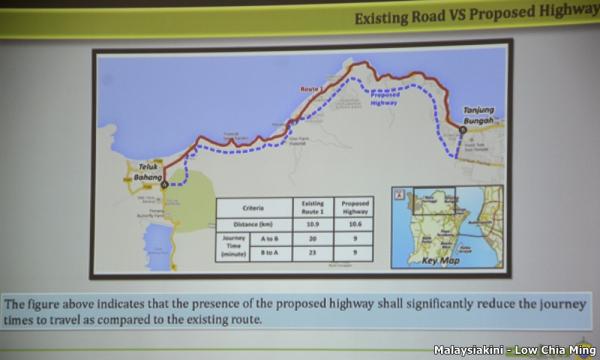On Sept 2 the Tanjong Bungah Residents Association held a press conference to voice their concerns on and opposition to the proposed 10km north coast paired road (NCPR) that is estimated to cost RM1bn or RM100m per kilometre.
The project is to be built in two phases – phase 1 stretching from Tanjong Bungah to Batu Ferringhi and the second phase from Batu Ferringhi to Teluk Bahang. The road will cut into 3.4 hectares of reserved forest land.
Penang exco member Lim Hock Seng said it was urgently needed and there are no alternatives.
Significantly, we learned from reliable internal sources that the Halcrow consultants did not recommend the building of this highway and the cross-channel tunnel in their original submission, as there was no urgent need.
The present road networks already have the capacity to handle 97% car modal share. But they were asked by the state government to include the highways in the revised final report submitted. The other two highways are the Ayer Itam-Relau Road and the Georgetown Outer Bypass.
In the final report, Halcrow proposed three interrelated sets of measures to address the transport problems. These are short to medium term (2012-2015), long-term (2015-2030), and institutional policies.
The short to medium term are proposals to make better use of the state’s existing transport networks. They are, so to speak, picking low-hanging fruits that will yield quick results.
These include the creation of a more efficient road hierarchy of district, state, and national highway networks, improving conditions for pedestrians, cyclists and motorcyclists, upgrading operations of existing signal intersections, strengthening regulations and enforcement of loading, waiting, parking and hawker activities that cause major traffic obstructions.
Sadly four years have passed and little has been done to address these issues. A few kilometres of bicycle lanes have been built, and some stretches of pedestrian walkways have been improved around Pulau TIkus.
Poor enforcement of regulations
But little has been done to shape up enforcement of regulations. Irresponsible parking is still a major cause of traffic obstruction.
Likewise, little has been done to strengthen institutional measures such as reviewing and improving on-street controlled parking, capacity building of the traffic and engineering staff, moving away from the use of “traffic impact assessments”, which have been ineffective and a failure, to a system of holistic thinking based on “transport related development contributions” and “transport accessibility audits” and the introduction of traffic demand management policies such as access charges, peak hours entry restrictions and high-occupancy-vehicle lanes.
Despite Halcrow’s advice and caution that building more highways without implementing institutional changes will be ineffective, the state has prioritised road building and poured practically all its resources in this direction.
The package of three major highways plus a tunnel will cost over RM6 billion, and a new Penang Island Link proposed by SRS, but not by the Halcrow consultants, will cost another RM7-8 billion.
In other words, a total of RM13 billion is allocated for highway construction. RM8 billion is planned for one public transport LRT line from George Town to the airport and the to-be-reclaimed islands.
Like climate change studies, there is overwhelming and incontrovertible scientific evidence to show that simply building more roads does not solve traffic congestion. On the contrary, while it may alleviate traffic congestion temporarily, it ultimately results in more congestion as such measures induce a higher traffic volume.
In other words, the solution lies not in simply supplying more roads but in managing the demand for the use of roads.
Finally, the proposal to build the NCPR reflects bad and fundamentally flawed planning as the four-lane highway ends at Lembah Permai, a highly populated area that is linked to Tanjong Tokong via a narrow two-lane road winding across the hills adjacent to a reservoir. This will create a major bottleneck.
Only as an afterthought, the state is now proposing another “viaduct” to cut through the sensitive hill area to cater to the traffic from the NCPR.
This no doubt will cost another billion ringgit or more. The state has not shown how this will be financed. If no financing is available, this project would be stillborn and we would have created another traffic problem without being better off.
While most progressive cities have turned to policies managing the demand side of the equation as recommended by the Halcrow consultants under institutional changes, the Penang state government, which takes pride in building intelligent cities, is adopting the ineffective and outdated approach of tackling only the supply side of the equation by building more roads.
When Lim Hock Seng talks of no alternatives, has he considered other policies measures and alternatives?
Penang Forum supports the call for a public dialogue to take another look at these issues if the state government is serious about its pronouncement of sustainable development.
Off-hand, a few alternatives should be considered, and detailed cost-benefit analyses for the different alternatives must be conducted by independent parties.
Maintain the existing road network and introduce traffic management policies as traffic congestion on the road occurs mainly during weekends and holiday seasons.
If a new road is absolutely necessary, it should be a two-lane (not four-lane) road limited to public transport cum high-occupancy vehicles. It should be done only for the first stretch of the NCPR. In other words, priority must always be for public transport
The costs and benefits of these other alternatives should be compared to that of the proposed NCPR and should be published online for public scrutiny. The Halcrow report explicitly stated that the NCPR “should have limited access, with NO frontage development” (Halcrow Report, October 2012, p24, emphasis added).
For all the above reasons, other cheaper and more sustainable alternatives with emphasis on public transport should be considered over the proposed NCPR.
PENANG FORUM is a coalition of 14 NGOs


